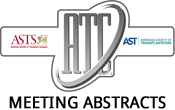2020 American Transplant Congress
Marginal Zone B Cells Support Donor-Specific Alloantibody Responses to Heart Allografts
Inflammation and Immunity, Cleveland Clinic, Cleveland, OH
*Purpose: Production of high affinity isotype-switched donor specific alloantibodies (DSA) after transplantation is associated with germinal center formation by follicular (FO) B cells whereas the…2020 American Transplant Congress
Hemodialysis (HD) Treatment Associates with Increased Risk of Delayed Graft Function (DGF) after Renal Transplantation (RT) and Augmented Cd4 and Cd8 T Cell Proliferation Compared to Peritoneal Dialysis (PD)
*Purpose: Delayed graft function (DGF) is a common event after RT that increases the risk of acute rejection and early graft loss. The impact of…2020 American Transplant Congress
PD-L1 Signals Lymphatic Endothelium for Treg Migration
*Purpose: Regulatory T cell (Treg) migration is important for tolerance, although the molecules that regulate Treg entry to lymphatics are poorly understood. Lymphatic endothelial cells…2020 American Transplant Congress
Thalidomide and Dexamethasone Combinatorial Treatment Induces Tolerogenic Signals by Systemic Immunomodulation of T Cells and Dendritic Cells
*Purpose: Preventing or reducing allograft rejection is critical in organ transplantation, and the need for immune modulation rather than immune suppression has been emphasized. Many…2020 American Transplant Congress
Determination of Programmed Cell Death Protein 1 (PD1) by Flow Cytometry, a Possible Follow-Up Tool in Renal Transplantation of High Immune Risk
*Purpose: Introduction: Currently, the follow-up of patients remains to be the serum creatinine level, being highly specific, however, with little sensitivity to determine the occurrence…2020 American Transplant Congress
B Cell Derived IL-1β and IL-6 Drive Homeostatic T Cell Recovery Following Lymphoablation
Inflammation and Immunity, Cleveland Clinic, Cleveland, OH
*Purpose: T cell reconstitution after lymphoablation in allograft recipients may lead to acute rejection and poor graft outcome. Using a mouse model of heart transplantation…2020 American Transplant Congress
Memory T Cell-Mediated Rejection is Regulated by FcγRIIB Expression on CD8+ T Cells
*Purpose: Donor-reactive memory T cells represent a potent immunologic barrier to long-term graft survival and tolerance induction. To identify novel pathways that regulate memory T…2020 American Transplant Congress
Feasibility and Long Term Safety of T Regulatory Cell Therapy in Kidney Transplantation
*Purpose: A sequential clinical trial of autologous polyclonal T regulatory cellular therapy compared with a standardised reference cohort of live donor kidney transplant recipients. The…2020 American Transplant Congress
Effector Differentiation of Endogenous Antigen-Specific CD8+ T Cells is Selectively Limited by CTLA-4 Ig
Emory Transplant Center, Emory University School of Medicine, Atlanta, GA
*Purpose: Costimulation blockade with belatacept (CTLA-4 Ig) offers improved renal function and reduced toxicity following transplantation compared to calcineurin inhibitors. Nonetheless, episodes of acute T…2020 American Transplant Congress
Granulocyte-Colony Stimulating Factor (G-CSF) and Granulocyte-Macrophage CSF (GM-CSF) Administration Enriches for Highly Suppressive CD4+CD45RA–Foxp3hi Cells in Leukapheresis Products of Rhesus Monkeys
Starzl Transplantation Institute, University of Pittsburgh School of Medicine, Pittsburgh, PA
*Purpose: In humans, CD4+CD45RA-Foxp3hi T cells comprise a regulatory T cell (Treg) subset with highly suppressive function. We have previously shown that granulocyte-colony stimulating factor…
- « Previous Page
- 1
- …
- 11
- 12
- 13
- 14
- 15
- …
- 53
- Next Page »
